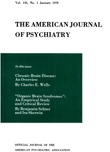A PROGRAM FOR "SEXUAL PSYCHOPATHS" IN A STATE MENTAL HOSPITAL
Abstract
This paper reports a program for sex offenders at a state hospital in California during the 2 fiscal years July 1, 1952, to June 30, 1954. The elements of the California law are outlined, including the determination of "sexual psychopathy," the basis of jurisdiction, the court medical examination and qualification of examiners, the disposition of the sex offender, the procedure for release from the hospital, and the voluntary commitment procedure.
The California "sexual psychopath" program is administered by the state hospitals, and is divided into 2 major phases: (1) commitment for a 90-day observation period, and (2) commitment for an indeterminate period of treatment. The first phase determines if the sex offender is a "sexual psychopath" as defined by law. If he is found to qualify and if he is likely to benefit by treatment he enters the hospital on an indeterminate basis and becomes a treatment patient.
Of the sex crimes perpetrated by 284 patients studied during this 2-year period over 50% involved children under the age of 14. For the most part, this pedophiliac activity did not include sexual intercourse. During the period of observation approximately one-half of the patients were selected to continue treatment in the hospital. The remainder were returned to court as either not being amenable to treatment or not fulfilling the criteria of a "sexual psychopath." A seasonal incidence of sex offenders was also noted with decreased admissions during the winter months. The 284 cases were classified according to 4 groups: (1) The normal; (2) the constitutionally abnormal; (3) the neurotic; and (4) the group with deteriorated ego control. About 70% of the cases fall into the neurotic group, which includes both the neuroses and some of the personality disorders.
The details of the treatment program are outlined, and our data indicate that intensive psychiatric treatment for the sex offender is justified. The program was structured with emphasis on group psychotherapy with extensive adjunctive aid, such as occupational and recreational therapy. During the period of intensive treatment approximately three-quarters of the patients were discharged as improved. During the early part of the program, before intensive treatment was instituted, fewer than 50% were discharged as improved.
For this study to be complete, it will be necessary to follow closely for a prolonged period patients who have been released as improved. Preliminary studies indicate a low percentage of recidivism.
Access content
To read the fulltext, please use one of the options below to sign in or purchase access.- Personal login
- Institutional Login
- Sign in via OpenAthens
- Register for access
-
Please login/register if you wish to pair your device and check access availability.
Not a subscriber?
PsychiatryOnline subscription options offer access to the DSM-5 library, books, journals, CME, and patient resources. This all-in-one virtual library provides psychiatrists and mental health professionals with key resources for diagnosis, treatment, research, and professional development.
Need more help? PsychiatryOnline Customer Service may be reached by emailing [email protected] or by calling 800-368-5777 (in the U.S.) or 703-907-7322 (outside the U.S.).



